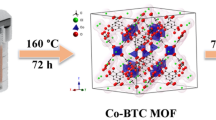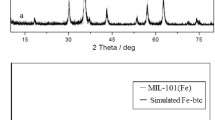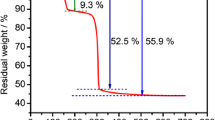Abstract
Controlling the morphology of metal–organic frameworks to improve their application in energy storage remains a particular challenge. In this work, hollow porous Co-MOF-74 nanocuboids consisting of nanothorn (< 7 nm) are designed through the linker exchange method for the improved MOFs-based anode of the lithium-ion battery. The Co-MOF-74 inherits the shape of cobalt acetate hydroxide prism and translates into the hollow structure due to the Kirkendall effect. The evolutions of morphology depending on temperature have been investigated further together with the lithium storage performances. Due to the combined merits from the high surface area inheriting from the nanocuboids and the coordination defects originating from the ultrasmall nanothorns, the Co-MOF-74 with optimized morphology exhibits a high reversible capacity and excellent cycle stability (up to 900 mAh g−1 at 1000 mA g−1 after 600 cycles). This work demonstrates an effective way for rational design and synthesis of MOFs-based electrodes for energy storage.
Graphical abstract










Similar content being viewed by others
References:
He B, Xu C, Tang Y, Qian Y, Liu H, Hao Q, Su Z (2019) Facile fabrication of a hierarchical NiCoFeP hollow nanoprism for efficient oxygen evolution in the Zn-air battery. J Mater Chem A 7:24964–24972. https://doi.org/10.1039/c9ta09239k
Huang D, Liang C, Chen L, Tang M, Zheng Z, Wang Z (2021) MOF composite fibrous separators for high-rate lithium-ion batteries. J Mater Sci 56:5868–5877. https://doi.org/10.1007/s10853-020-05559-6
Jiao X, Hao Q, Xia X, Wu Z, Lei W (2019) Metal organic framework derived Nb2O5@C nanoparticles grown on reduced graphene oxide for high-energy lithium ion capacitors. Chem Commun 55:2692–2695. https://doi.org/10.1039/c9cc00387h
Zou L, Hou CC, Liu Z, Pang H, Xu Q (2018) Superlong single-crystal metal-organic framework nanotubes. J Am Chem Soc 140:15393–15401. https://doi.org/10.1021/jacs.8b09092
Jiang Y, Zhao H, Yue L, Liang J, Li T, Liu Q, Luo Y, Kong X, Lu S, Shi X, Zhou K, Sun X (2021) Recent advances in lithium-based batteries using metal organic frameworks as electrode materials. Electrochem Commun. https://doi.org/10.1016/j.elecom.2020.106881
Li C, Liu L, Kang J, Xiao Y, Feng Y, Cao F-F, Zhang H (2020) Pristine MOF and COF materials for advanced batteries. Energ Storage Mater 31:115–134. https://doi.org/10.1016/j.ensm.2020.06.005
Li X, Cheng F, Zhang S, Chen J (2006) Shape-controlled synthesis and lithium-storage study of metal-organic frameworks Zn4O(1,3,5-benzenetribenzoate)2. J Power Sources 160:542–547. https://doi.org/10.1016/j.jpowsour.2006.01.015
Gou L, Hao L-M, Shi YX, Ma S-L, Fan X-Y, Xu L, Li D-L, Wang K (2014) One-pot synthesis of a metal–organic framework as an anode for Li-ion batteries with improved capacity and cycling stability. J Solid State Chem 210:121–124. https://doi.org/10.1016/j.jssc.2013.11.014
An T, Wang Y, Tang J, Wang Y, Zhang L, Zheng G (2015) A flexible ligand-based wavy layered metal-organic framework for lithium-ion storage. J Colloid Interface Sci 445:320–325. https://doi.org/10.1016/j.jcis.2015.01.012
Maiti S, Pramanik A, Manju U, Mahanty S (2016) Cu3(1,3,5-benzenetricarboxylate)2metal-organic framework: A promising anode material for lithium-ion battery. Microporous Mesoporous Mater 226:353–359. https://doi.org/10.1016/j.micromeso.2016.02.011
Lou X, Hu H, Li C, Hu X, Li T, Shen M, Chen Q, Hu B (2016) Capacity control of ferric coordination polymers by zinc nitrate for lithium-ion batteries. RSC Adv 6:86126–86130. https://doi.org/10.1039/c6ra17608a
Gao C, Jiang Z, Wang P, Jensen LR, Zhang Y, Yue Y (2020) Optimized assembling of MOF/SnO2/Graphene leads to superior anode for lithium ion batteries. Nano Energy 74:104868. https://doi.org/10.1016/j.nanoen.2020.104868
Mikita R, Ogihara N, Takahashi N, Kosaka S, Isomura N (2020) Phase transition mechanism for crystalline aromatic dicarboxylate in Li+ intercalation. Chem Mater 32:3396–3404. https://doi.org/10.1021/acs.chemmater.9b04984
Wu Y, Zhao H, Wu Z, Yue L, Liang J, Liu Q, Luo Y, Gao S, Lu S, Chen G, Shi X, Zhong B, Guo X, Sun X (2021) Rational design of carbon materials as anodes for potassium-ion batteries. Energ Storage Mater 34:483–507. https://doi.org/10.1016/j.ensm.2020.10.015
Zhang C, Hu W, Jiang H, Chang J-K, Zheng M, Wu Q-H, Dong Q (2017) Electrochemical performance of MIL-53(Fe)@RGO as an Organic Anode Material for Li-ion Batteries. Electrochim Acta 246:528–535. https://doi.org/10.1016/j.electacta.2017.06.059
Zhou D, Ni J, Li L (2019) Self-supported multicomponent CPO-27 MOF nanoarrays as high-performance anode for lithium storage. Nano Energ 57:711–717. https://doi.org/10.1016/j.nanoen.2019.01.010
Wei R, Dong Y, Zhang Y, Zhang R, Al-Tahan MA, Zhang J (2020) In-situ self-assembled hollow urchins F-Co-MOF on rGO as advanced anodes for lithium-ion and sodium-ion batteries. J Colloid Interface Sci 582:236–245. https://doi.org/10.1016/j.jcis.2020.08.044
Xiao P, Bu F, Zhao R, Aly Aboud MF, Shakir I, Xu Y (2018) Sub-5 nm Ultrasmall Metal-Organic Framework Nanocrystals for Highly Efficient Electrochemical Energy Storage. ACS Nano 12:3947–3953. https://doi.org/10.1021/acsnano.8b01488
Feng L, Li J-L, Day GS, Lv X-L, Zhou H-C (2019) Temperature-controlled evolution of nanoporous MOF crystallites into hierarchically porous superstructures. Chem 5:1265–1274. https://doi.org/10.1016/j.chempr.2019.03.003
Qiu T, Gao S, Liang Z, Wang DG, Tabassum H, Zhong R, Zou R (2020) Pristine hollow metal-organic frameworks: design, synthesis and application. Angew Chem Int Ed Engl 60:2–25. https://doi.org/10.1002/anie.202012699
Zhang X, Chuah CY, Dong P, Cha YH, Bae TH, Song MK (2018) Hierarchically porous Co-MOF-74 hollow nanorods for enhanced dynamic CO2 separation. ACS Appl Mater Interfaces 10:43316–43322. https://doi.org/10.1021/acsami.8b17180
Dodson RA, Kalenak AP, Matzger AJ (2020) Solvent choice in metal-organic framework linker exchange permits microstructural control. J Am Chem Soc 142:20806–20813. https://doi.org/10.1021/jacs.0c10224
Fan M, Liao D, Aboud MFA, Shakir I, Xu Y (2020) A universal strategy toward ultrasmall hollow nanostructures with remarkable electrochemical performance. Angew Chem Int Ed Engl 59:8247–8254. https://doi.org/10.1002/anie.202000352
Zheng X, Jia G, Fan G, Luo W, Li Z, Zou Z (2020) Modulation of disordered coordination degree based on surface defective metal-organic framework derivatives toward boosting oxygen evolution electrocatalysis. Small 16:e2003630. https://doi.org/10.1002/smll.202003630
Liao Y, Li C, Lou X, Wang P, Yang Q, Shen M, Hu B (2017) Highly reversible lithium storage in cobalt 2,5-dioxido-1,4-benzenedicarboxylate metal-organic frameworks boosted by pseudocapacitance. J Colloid Interface Sci 506:365–372. https://doi.org/10.1016/j.jcis.2017.07.063
Zhao X, Pattengale B, Fan D, Zou Z, Zhao Y, Du J, Huang J, Xu C (2018) Mixed-node metal-organic frameworks as efficient electrocatalysts for oxygen evolution reaction. ACS Energy Lett 3:2520–2526. https://doi.org/10.1021/acsenergylett.8b01540
Yue L, Ma C, Yan S, Wu Z, Zhao W, Liu Q, Luo Y, Zhong B, Zhang F, Liu Y, Alshehri AA, Alzahrani KA, Guo X, Sun X (2021) Improving the intrinsic electronic conductivity of NiMoO4 anodes by phosphorous doping for high lithium storage. Nano Res. https://doi.org/10.1007/s12274-021-3455-3
Yao D, Wang F, Lei W, Hua Y, Xia X, Liu J, Hao Q (2020) Oxygen vacancies boosting ultra-stability of mesoporous ZnO-CoO@N-doped carbon microspheres for asymmetric supercapacitors. Science China-Materials 63:2013–2027. https://doi.org/10.1007/s40843-020-1357-9
Xi G, Jiao X, Peng Q, Zeng T (2021) Anchored CoCO3 on peeled graphite sheets toward high-capacity lithium-ion battery anode. J Mater Sci 56:10510–10522. https://doi.org/10.1007/s10853-021-05933-y
Nagaraju G, Sekhar SC, Ramulu B, Hussain SK, Narsimulu D, Yu JS (2020) Ternary MOF-based redox active sites enabled 3d-on-2d nanoarchitectured battery-type electrodes for high-energy-density supercapatteries. Nano-Micro Letters 13:17. https://doi.org/10.1007/s40820-020-00528-9
Ouyang Y, Huang R, Xia X, Ye H, Jiao X, Wang L, Lei W, Hao Q (2019) Hierarchical structure electrodes of NiO ultrathin nanosheets anchored to NiCo2O4 on carbon cloth with excellent cycle stability for asymmetric supercapacitors. Chem Eng J 355:416–427. https://doi.org/10.1016/j.cej.2018.08.142
Aminu IS, Geaney H, Imtiaz S, Adegoke TE, Kapuria N, Collins GA, Ryan KM (2020) A copper silicide nanofoam current collector for directly grown Si nanowire networks and their application as lithium-ion anodes. Adv Func Mater 30:2007238. https://doi.org/10.1002/adfm.202003278
Bi R, Xu N, Ren H, Yang N, Sun Y, Cao A, Yu R, Wang D (2020) A hollow multi-shelled structure for charge transport and active sites in lithium-ion capacitors. Angew Chem Int Ed Engl 59:4865–4868. https://doi.org/10.1002/anie.201914680
Mutahir S, Wang C, Song J, Wang L, Lei W, Jiao X, Khan MA, Zhou B, Zhong Q, Hao Q (2020) Pristine Co(BDC)TED0.5 a pillared-layer biligand cobalt based metal organic framework as improved anode material for lithium-ion batteries. Appl Mater Today 21:100813. https://doi.org/10.1016/j.apmt.2020.100813
Ding Y, Hu L, He D, Peng Y, Niu Y, Li Z, Zhang X, Chen S (2020) Design of multishell microsphere of transition metal oxides/carbon composites for lithium ion battery. Chem Eng J 380:122489. https://doi.org/10.1016/j.cej.2019.122489
Gong F, Xia D, Li M, Zhou Q, Wang D, Zhang P, Zhang Y (2020) Direct thermal pyrolysis enabling the use of cobalt oxides nanoparticles from commercial acetates as high-capacity anodes for lithium-ion batteries. Ind Eng Chem Res 59:13564–13571. https://doi.org/10.1021/acs.iecr.0c01895
Shan Y, Li Y, Pang H (2020) Applications of tin sulfide-based materials in lithium-ion batteries and sodium-ion batteries. Adv Func Mater 30:2001298. https://doi.org/10.1002/adfm.202001298
Zhao W, Gao L, Yue L, Wang X, Liu Q, Luo Y, Li T, Shi X, Asiri AM, Sun X (2021) Constructing a hollow microflower-like ZnS/CuS@C heterojunction as an effective ion-transport booster for an ultrastable and high-rate sodium storage anode. Journal of Materials Chemistry A 9:6402–6412. https://doi.org/10.1039/d1ta00497b
Zheng X, Jia G, Fan G, Luo W, Li Z, Zou Z (2020) Modulation of disordered coordination degree based on surface defective metal-organic framework derivatives toward boosting oxygen evolution electrocatalysis. Small 16:2003630. https://doi.org/10.1002/smll.202003630
Acknowledgements
This work was supported by the National Natural Science Foundation of China (Nos. 51972173, 51872140), Program Foundation for Science and Technology of Changzhou, China (CZ20190001), and the program for Science and Technology Innovative Research Team in Universities of Jiangsu Province.
Author information
Authors and Affiliations
Corresponding authors
Additional information
Handling Editor: Mark Bissett.
Publisher's Note
Springer Nature remains neutral with regard to jurisdictional claims in published maps and institutional affiliations.
Supplementary Information
Below is the link to the electronic supplementary material.
Rights and permissions
About this article
Cite this article
Song, JJ., He, B., Wang, X. et al. Hollow porous nanocuboids cobalt-based metal–organic frameworks with coordination defects as anode for enhanced lithium storage. J Mater Sci 56, 17178–17190 (2021). https://doi.org/10.1007/s10853-021-06341-y
Received:
Accepted:
Published:
Issue Date:
DOI: https://doi.org/10.1007/s10853-021-06341-y




